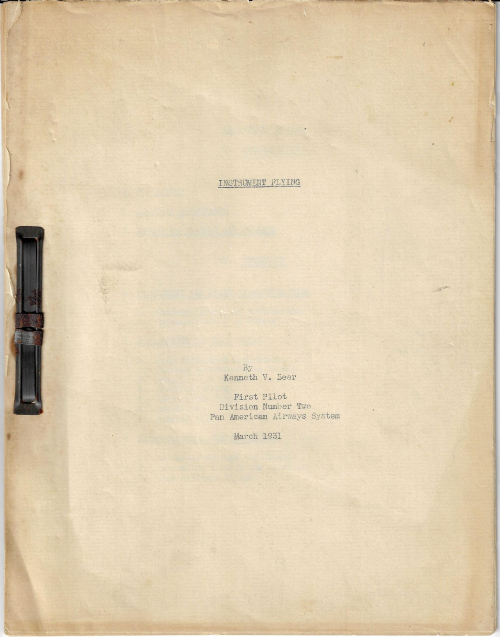BEER, Kenneth V. Instrument Flying. (Pan American Airways System) March 1931, 11x8.5", 19 leaves, offset printing. Two-hole punch at the left margin, bound with metal flexible clasps. Between Good and Very Good condition. Not located in the OCLC/WorldCat. $750
Beer was "First Pilot, Division Number Two, Pan American Airways System") and was evidently testing systems out for PanAm--and had in fact been doing so for two years at this point. He states in the introduction that "because (instrument flying) is important...and there doesn't seem much known about it, and still less written concerning it..." as the reasons why he undertook to gather his thoughts on the subject. He then gives a broad overview of the subject, looking at "technique" (including characteristics of instruments), "description of the process" ("each instrument separately", "reading instruments in groups", "synchronization", "rough air", "loss of one engine"), "meteorological considerations" ("ascending through clouds", "high altitude flying" for example). A third section is "tests with instrument flying/instruction plane", looking at the methods of conducting tests (for various types of turns and dives, glides, tight spiral, spins); a fourth on "psychology" ("at first pilot has erroneous feelings") and then a fifth and final section on dangers and advantages. All in all a very interesting, concise, and broad review of the earliest days of instrument flying, and gives a real taste for the difficulties in flight when discussing how useful instrument flying would prove in conditions of low visibility/clouds/fogs and that sort of now-easily-surmountable early flight troubles.
It is interesting to note that Beer writes about seven instruments--one more than the RAF established as their basic instrumentation. Included in this report are the unnamed turn indicator, bank indicator, climb indicator, and then the airspeed meter, compass, and altimeter. (No mention of Jimmy Doolittle's historic first take/off and landing by instruments in 1929!)
“CAPTAIN KENNETH V. BEER has flown 27 years for Pan American. He has 23,000 pilot hours and is PAA's senior captain in the Pacific Division. He was the 26th pilot to join Pan American.” --Pan American's “Meet Your Captain” brochure, 1952
“Forming the nucleus for expanded operations, veteran Pan American pilots piled up thousands of additional hours of wartime flying. Capt. Kenneth V. Beer now in charge of flight training, added some 1,340 hours of wartime flying to a 13,ooo-odd peacetime log which included the first passenger flight to New Zealand. Incidentally, he was one of three Coronado pilots who rushed :Marine torpedo bomber ground crews to Midway during the crucial hours of that decisive battle in 1942.”--Aircraft Yearbook, 1945




Comments